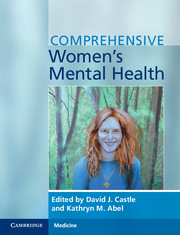Book contents
- Comprehensive Women’s Mental Health
- Comprehensive Women’s Mental Health
- Copyright page
- Contents
- Contributors
- Preface
- Section 1 The social, genetic and environmental aspects
- Section 2 Hormonal and reproductive effects
- Chapter 8 The effects of hormones on the female brain across the lifespan
- Chapter 9 Sexual, reproductive and antenatal care of women with mental illness
- Chapter 10 Mood, anxiety and obsessive compulsive disorders in pregnancy and the postpartum period
- Chapter 11 Pharmacological treatment of mental health problems in pregnancy and lactation
- Section 3 Violence, self-harm and substance misuse
- Section 4 Depression, anxiety and related disorders
- Section 5 Psychotic disorders in women
- Index
- References
Chapter 8 - The effects of hormones on the female brain across the lifespan
from Section 2 - Hormonal and reproductive effects
Published online by Cambridge University Press: 05 March 2016
- Comprehensive Women’s Mental Health
- Comprehensive Women’s Mental Health
- Copyright page
- Contents
- Contributors
- Preface
- Section 1 The social, genetic and environmental aspects
- Section 2 Hormonal and reproductive effects
- Chapter 8 The effects of hormones on the female brain across the lifespan
- Chapter 9 Sexual, reproductive and antenatal care of women with mental illness
- Chapter 10 Mood, anxiety and obsessive compulsive disorders in pregnancy and the postpartum period
- Chapter 11 Pharmacological treatment of mental health problems in pregnancy and lactation
- Section 3 Violence, self-harm and substance misuse
- Section 4 Depression, anxiety and related disorders
- Section 5 Psychotic disorders in women
- Index
- References
- Type
- Chapter
- Information
- Comprehensive Women's Mental Health , pp. 81 - 89Publisher: Cambridge University PressPrint publication year: 2016



